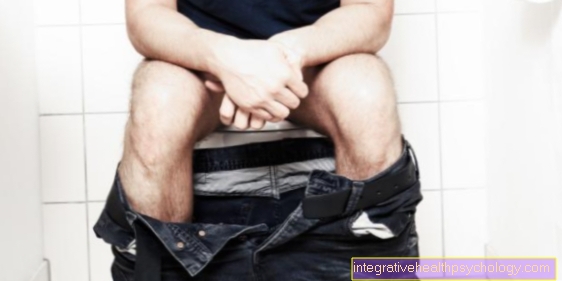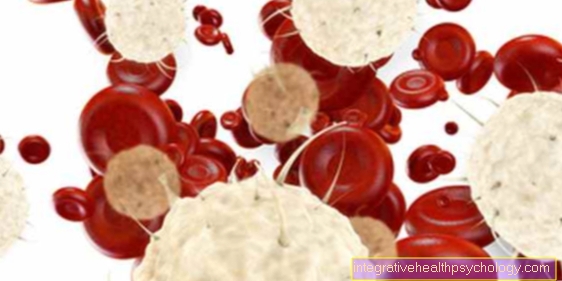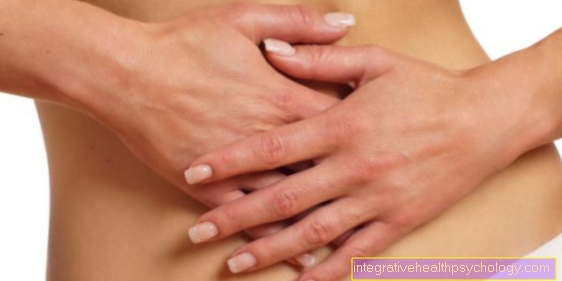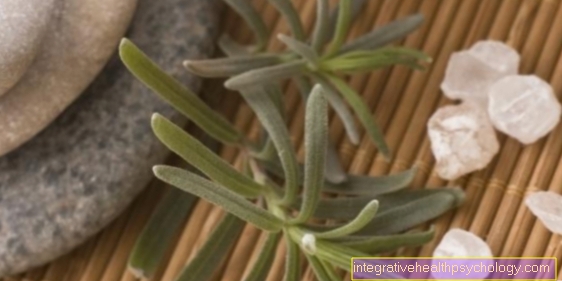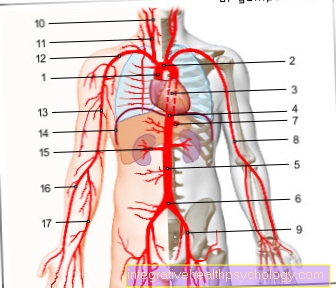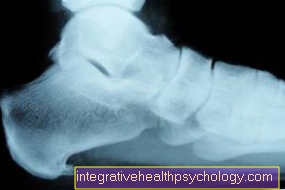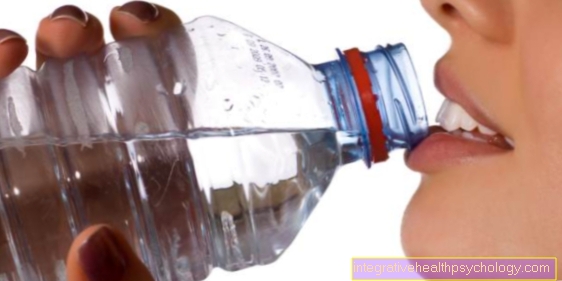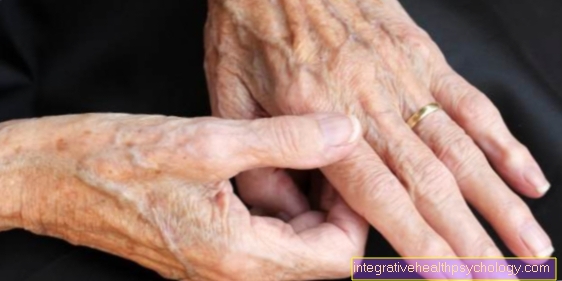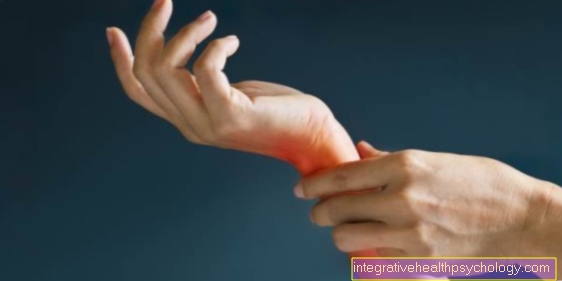Sweaty hands
definition
Sweaty hands are also called in medical jargon Hyperhidrosis palmaris designated. There is excessive perspiration in the area of the palms of the hands. This can be so pronounced that the hands are really wet.
About 1-2% of the population suffer from excessive sweating (Hyperhidrosis). Severely affected people often suffer from psychological symptoms because the illness is extremely uncomfortable for them. It is therefore not uncommon for social avoidance behavior with withdrawal to occur. There are various therapeutic approaches to treating sweaty hands.

causes
The cause of sweaty hands is an overactivity of the sweat glands in the area of the palms. This arises either from the fact that the sweat glands are particularly large and therefore produce a lot of sweat or because the vegetative nervous system is overactive.
The autonomic nervous system controls our unconscious body functions such as heartbeat, breathing, digestion and sweating. Why exactly the vegetative nervous system is overactive in those affected or why the sweat glands are larger than usual has not yet been clarified. However, there appears to be a distinct genetic component.
Mental causes
Sweaty hands can end up in a kind of vicious circle. Those affected are psychologically stressed, are afraid of interpersonal contact with shaking hands and sometimes develop a pronounced avoidance behavior. The resulting psychological stress reaction increases sweating in the area of the palms.
The vicious circle begins with increased sweating, followed by a pronounced fear of sweating due to strong feelings of shame. The consequence is even greater sweating.
Many of those affected do not have sweaty hands in everyday life. Increased sweating in the palm area only occurs in situations in which they are excited, anxious or stressed. This is related to the fact that stress or tension is a part of the autonomic nervous system, the Sympathetic, stimulates. If this is active, it ensures, among other things, increased activity of the sweat glands, resulting in increased sweat production.
Stress or nervousness
It is not uncommon for emotional causes such as stress or fear to be at least partly responsible for excessive perspiration.The sweat glands on the palm of the hand are stimulated by the part of the nervous system that puts our body on alert (“fight or flight principle”, with which humans protect themselves from obvious dangers), the so-called sympathetic nervous system. In stressful situations and under constant tension, in addition to palpitations and extreme tension, there is also a strong sweat secretion, especially on the palms of the hands. In turn, this excessive sweating can be avoided in stressful situations such as Conversations with the supervisor or certain social situations can be very unpleasant, which increases the stress and tension of those affected. A vicious cycle of excessive sweating, tension, and social restrictions can result.
Hyperthyroidism
With an overactive thyroid, more thyroid hormones are released into the body's circulation, which among other things leads to an excessive tendency to sweat. This generally affects the entire body, but can be particularly pronounced on the palms of the hands. Other possible symptoms of an overactive thyroid are palpitations and a too fast pulse, diarrhea, hair loss and unwanted weight loss. If the thyroid function can be normalized with medication, then the sweat problem is usually also reduced.
You might also be interested in: Therapy of an overactive thyroid
diagnosis
The diagnosis of sweaty hands is usually mainly clinical.
The anamnesis is primarily decisive. How long have the complaints existed? When do they occur? Are they permanent or only in certain situations? Are there relatives with similar problems? Is the excessive sweating only noticeable on the hands or, for example, on the feet or in the armpits?
In general, a physical exam should follow. An iodine tincture, which is applied to the palms of the hands and dried, can also be used to detect increased sweat gland production. After the iodine tincture has dried, potato starch is powdered. Subsequently emerging sweat turns the applied mixture blue. The more intense the blue, the stronger the sweat secretion.
This test can also be used as a follow-up to assess whether a therapy has worked.
Concomitant symptoms
Patients with sweaty hands can also sweat more in other parts of the body. Feet and armpits in particular come into question here.
As already described above, patients with profuse perspiration on their hands often suffer from psychological complaints because they feel ashamed. They avoid situations in which a handshake may be necessary. A vicious circle often develops from sweating and fear of further sweating.
In the worst case, those affected withdraw more and more from everyday life in order to avoid social contacts as much as possible.
Sweaty feet
Most sweat glands are found in the palms of the hands, soles of the feet, and armpits. In this respect, the strongest perspiration occurs in these areas.
As with the sweaty hand, the sweaty foot can lead to an overproduction of sweat. One speaks of a in technical jargon Hyperhidrosis pedis. Either there is an isolated overproduction of sweat in the area of the soles of the feet or the hands and feet (and armpits) are affected. Sweaty feet are not as stressful for those affected as sweaty hands in social interaction, but they can also be excruciating.
The diagnosis is made in a similar way to that of sweaty hands. The medical history is most important. Applying tincture of iodine and potato starch can make the increased sweat secretion visible and thus objectify the complaints complained about by the patient.
Simple measures against sweaty feet are regular foot baths, putting skin cream on the feet, frequent barefoot running, wearing breathable shoes that are regularly changed and the use of insoles that have an odor-inhibiting effect.
Medical therapy is similar to that of sweaty hands and is explained below.
With babies
It is not uncommon for very young children to have their hands and feet sweaty. This is probably due to the fact that the heat regulation (part of the autonomic nervous system) in newborns is not yet fully developed. It takes a few months for these processes to function adequately.
Sweaty hands or feet in newborns are therefore usually no cause for concern. In general, it should always be ensured that the newborn is not too warm but not too cold. However, other symptoms should be noted. If the child sweats all over the body, has a gray-pale skin color, looks whimsy and lazy to drink, the body temperature should be measured and a doctor should be consulted. If, on the other hand, the child has no fever and rosy skin with good blood circulation, sweaty hands are not unusual.
What can you do about sweaty hands?
There are several non-medical home remedies that are believed to be effective against sweaty hands. They are mentioned below.
Medical therapy is divided into surgical and non-surgical measures. An agent that is also found in numerous antiperspirants (deodorants) is aluminum chloride. It is not only available in deodorant spray or roll-on form, but also as a gel. It should be applied to the affected areas (palm / soles of the feet) in the evening so that it can take effect. As with aluminum chloride in the armpit area, the result is reduced sweat production. This is achieved by clogging the sweat glands.
Since the agent is relatively irritating to the skin, i.e. it can lead to itching and skin irritation, it should be applied sparingly. It should be used daily, especially at the beginning. If successful, an attempt should be made to increase the intervals between treatments during the course. Aluminum chloride products are available in pharmacies without a prescription. The effectiveness, i.e. the success of the treatment, varies from person to person.
Another non-surgical method of treatment is the so-called Tap water iontophoresis. Hands / feet are held in two separate water containers. There is an electrode in each container. The electrodes are connected to a voltage source. If the hands / feet are now immersed in the tubs, ions are transported through the skin. The current can be felt in the form of a tingling sensation, but should not be painful. To begin with, this type of therapy must be done 4-5 times a week for 15-20 minutes. After about 6 weeks, the frequency of use can be reduced. 1-2 sessions per week are sufficient. The effectiveness of this method is described as relatively high.
The devices with which tap water iontophoresis can be carried out are not only available in clinics or practices. They can also be purchased for home use. If a prescription is presented, the costs for the device are usually covered by the health insurance company.
Another possibility against excessive sweat production are tablets that reduce the effect of the messenger substance Acetylcholine inhibit in the body. This group of drugs is called Anticholinergics designated. However, they are only approved for the treatment of severe underarm sweat, not for the treatment of sweaty hands or feet.
Another non-operative measure is the injection of Botulinum toxin (popularly: Botox) in the affected areas. Depending on the provider (dermatology practice / dermatology clinic), the information on whether the procedure is recommended under local or short anesthesia varies. However, short general anesthesia is more often recommended for use on hands / feet, as the punctures in these areas are relatively painful. The effect is usually very satisfactory, but wears off after 4-6 months, so that the treatment then has to be repeated. The costs per treatment amount to 400-1000 euros and are usually not covered by statutory health insurance.
A surgical variant to prevent sweaty hands is that endoscopic thoracic sympathetic block. It is described in more detail in the next paragraph.
OP
That comes as surgical therapy endoscopic thoracic sympathetic block in question. The aim here is to specifically block the part of the autonomic nervous system that, among other things, stimulates sweat production. The effect is that the sweat production in the armpits and hands is suppressed.
In the past, the corresponding nerve cords were cut. Today they are more likely to be blocked by attaching clips. The advantage of this variant is that it is reversible, so the clips can be removed again.
The main side effect of this surgical procedure is a reflex or compensatory increased sweating in other parts of the body. This means that after the nerve part is blocked, the body looks for other areas to ensure sweat production. For example, there is increased sweating on the back, stomach, buttocks or thighs. Sometimes this compensatory sweating is even more stressful than the sweaty hands themselves, so it makes sense to have the possibility of reversibility.
The procedure is performed under general anesthesia. It is a minimally invasive procedure that does not involve large incisions. The costs are usually borne by the statutory health insurance funds.
This is one of the possible side effects Horner syndrome. Here a nerve knot is injured. This leads to a drooping eyelid. Also can Recurrent nerve injured, this leads to permanent hoarseness. Other possible side effects include injury to the lungs (Pneumothorax), heart or pleurisy (Peritonitis) as well as wound healing disorders and infections. Surgical therapy should always be the last option after all other non-surgical therapy options have been exhausted.
The costs of endoscopic transthoracic sympathectomy are covered by health insurance in Germany. For this purpose, the patient should contact his health insurance company before the operation to clarify that an indication has been made by a specialist (usually a dermatologist) and that the reimbursement is thus given.
Home remedies for sweaty hands
There are several possible home remedies for treating sweaty hands. Washing gels can be used to counteract oily skin. Rubbing the hands with body powder several times a day is also stated to be helpful. The powder does not inhibit the production of sweat, but it absorbs the existing sweat, so that the moisture of the hands is reduced.
Rubbing your hands with rubbing alcohol several times a day is said to be another means of reducing sweat production.
Drinking sage tea can also counteract sweat production. It can also be used as a hand or foot bath.
Furthermore, boiled oak bark can act as a hand or foot bath against excessive sweat secretion.
Homeopathy for sweaty hands
Various homeopathic remedies are used against sweaty hands, these are mainly mineral salts. Kalium iodatum, Kalium phosphoricum (potassium dihydrogen phosphate) and Kalium sulfucirum (potassium sulfate) have proven successful.
In milder cases of sweaty hands, the preparations can help to improve the situation, however, clear study results regarding the success of therapy in sweaty hands are not yet available. However, anyone who has already had good experience with homeopathic preparations in the past can attempt therapy with such mineral salts before more invasive procedures are used.
Botox
The importance of Botox for treating sweaty hands has already been explained in detail above.
During therapy, many small injections of botulinum toxin are given into the soles of the hands or feet / armpits. This blocks the transfer of information to nerve cells so that sweat production is significantly reduced.
The costs of the therapy usually have to be borne by the patient.
Electric bath as therapy
The current bath therapy (tap water iontophoresis) uses direct current to change the ion transport in the sweat glands and thus reduces perspiration. To do this, the hands are placed in a water bath and a maximum of 15mA direct current is applied via an electrode, which leads to a slight tingling sensation. The procedure must first be carried out several times a week and then helps a large number of those affected to achieve a significant improvement. However, no lasting effect is to be expected, so that as maintenance therapy, the power bath must continue to be used once or twice a week over the long term. However, the corresponding devices are usually reimbursed by the health insurance company so that those affected can carry out the therapy independently at home.
Acupuncture as therapy
Acupuncture aims to reduce the tendency to sweat excessively by sticking needles in certain parts of the body. A clear scientific effect has not been proven with regard to sweaty hands, so that the treatment is not covered by all health insurance companies. The effect is individual from patient to patient and usually only takes place over the course of several sessions. However, acupuncture can be an attempt to alleviate the symptoms, particularly if other treatment methods are unsuccessful.
Read more about this here: Acupuncture
forecast
Sweaty hands are usually something that develops over the years (more often during puberty) and then does not regress. So mostly it's a permanent problem. With the treatment methods mentioned above, however, there are numerous starting points for effective therapy to make life with the sweaty hands easier for those affected.
Particularly good effects are achieved with botulinum toxin therapy. The same applies to tap water iontophoresis. The disadvantage, however, is that these treatments have to be repeated over and over again.
Which doctor treats sweaty hands?
Anyone who suffers from an excessive tendency to sweat in their hands should contact a doctor as early as possible if they are suffering from it, as the symptoms usually do not improve on their own and home remedies often do not provide sufficient improvement. The family doctor who can rule out certain underlying diseases (e.g. hyperthyroidism) and take further measures depending on the patient's level of suffering is suitable as the first point of contact. In most cases, a referral to a dermatologist is recommended, as sweaty hands are most likely to fall into his area of expertise.


